|
|
|
|
 Inside the Shrine - Shintō Concepts, What’s What Inside the Shrine - Shintō Concepts, What’s What
Most visitors to Japan arrive with great enthusiasm toward Shintō sites, but after two or three shrine visits they soon experience shrine burnout. The key to appreciating Shintō shrines (and Buddhist temples for that matter) is to know a little bit about Shintō, its traditions, and its deities. Such knowledge will greatly improve your level of enjoyment. If you don't know what is inside the shrine (or temple), you will soon lose enthusiasm. Also remember. Shintō shrines have little to see in the way of statuary. If your goal is to see statuary, please visit Buddhist temples. Shrines have more things to do -- like having your fortune told and reading the prayers / wishes of visitors -- but statuary is not their forte. Rather, shrines specialize in spirits, sacred incantations, and talismans. Lovers of statuary should therefore plan accordingly. Shintō deities are generally called KAMI 神 or SHIN 神. But they are also known by many other names to distinguish them from their Buddhist counterparts. See Shintō Deities & Creatures for details.
WHAT’S ON THIS PAGE
- Purification (Water, Washing of Hands)
- Purification Terminology & Concepts
- Purification (Salt and Sumo)
- Etiquette When Praying (Clapping of Hands)
- Regalia (Three Treasures: Mirror, Sword, Jewel)
- Magatama Jewel & Talisman
- Animal Guardians (Fox, Lion-Dogs, Monkey)
- Torii (Gates)
- Shimenawa (Sacred Rope)
- Buildings (Main Structures, the Haiden, Honden, and Heiden)
- Shintō Architecture
- Lucky Charms, Fortune Telling (Omamori, O-inori, Hamaya, Ema, Omikuji)
- Dancing and Music (Kagura and Gagaku)
- Rice, Mochi, and Sake
- Scriptures and Texts

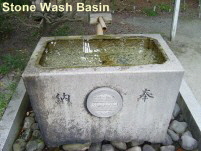  Purification: Water and Washing of Hands Purification: Water and Washing of Hands
Purification is an essential element in Shintō. The Shintō elements that provide purification are water, salt, fire, sand, and sake (alcohol). Before praying to the Shintō deity, worshippers and casual visitors are asked to purify themselves (Harai 祓い) of impurity. The act of cleansing or exorcising impurity is called Misogi 禊 or Misogi Harai 禊祓い, and the actual washing of hands with water is called Temizu 手水. An associated term is Imi 忌, meaning “abstention from defilement.” Most large shrines have a stone wash basin where worshippers and casual visitors rinse their mouth and hands before approaching the deity (most people no longer rinse their mouth). First the left and then the right hand is rinsed with water at the purification font, then the mouth is rinsed with water from the left hand.
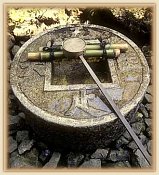 Sometimes, in the shrine compound, there will be a fire burning, and people will waft the smoke over their heads (reportedly to catch the blessings of the deity or to burn away impurities). Some Japanese still practice the old tradition of sprinkling water at the gate of their home in the morning and evening to purify the family environs. In addition, purification ceremonies precede the commencement of all important events and functions in Japan. When a new building or home is to be constructed, a groundbreaking ceremony called Jichinsai 地鎮祭 is performed to pacify the earth kami 神 (Shintō deity) and to purify the spot where construction will take place. New airplanes are purified before their maiden flight. New car owners take their vehicles to shrines to be purified (to be washed and prayed upon). Sometimes, in the shrine compound, there will be a fire burning, and people will waft the smoke over their heads (reportedly to catch the blessings of the deity or to burn away impurities). Some Japanese still practice the old tradition of sprinkling water at the gate of their home in the morning and evening to purify the family environs. In addition, purification ceremonies precede the commencement of all important events and functions in Japan. When a new building or home is to be constructed, a groundbreaking ceremony called Jichinsai 地鎮祭 is performed to pacify the earth kami 神 (Shintō deity) and to purify the spot where construction will take place. New airplanes are purified before their maiden flight. New car owners take their vehicles to shrines to be purified (to be washed and prayed upon).
 Two Japanese characters are often written on the stone wash basin and elsewhere at the shrine. The term is Hōnō 奉納, which means votive offering (donation). It is typically written on the purification font (stone water basin) and on the offering box. Hōnō 奉納 or Hōnōbutsu 奉納物 = Votive Offering. Two Japanese characters are often written on the stone wash basin and elsewhere at the shrine. The term is Hōnō 奉納, which means votive offering (donation). It is typically written on the purification font (stone water basin) and on the offering box. Hōnō 奉納 or Hōnōbutsu 奉納物 = Votive Offering.

 Purification Terminology & Concepts Purification Terminology & Concepts
- Chōzuya 手水舎. Area to clean hands & rinse mouth before praying to the deities.
- Harai 祓い or Oharai お祓い. Cleansing, Purification.
- Imi 忌. Means avoidance or things to avoid. Impurities. The act of keeping one's mind and body pure. Abstention from defilement. This kanji is also associated with mourning, taboo, or misfortune, hence the need to remain pure of mind and body. Shintō abhors impurity, and thus all impurity must be avoided -- “imi” is the name given to all things to avoid. In Shintō, the period of mourning following death is also referred to as “imi.” Another term, Imikotoba 忌言葉, literally means “words to be avoided.” The term Imina originally referred to the name of the deceased while still alive, but now it refers to the posthumous name.
- Misogi 禊 & Misogi Harai 禊祓い. Ablutions to remove sin or illness. The act of cleansing. This concept traces its origin to the Kojiki 古事記 (Record of Ancient Matters, 712 AD; see Scriptures & Texts below). The Kojiki presents numerous tales about Japan’s creation. One is about Izanagi-no-Mikoto, the primordial ancestral kami who purifies himself with water and thereby rids himself of the impurities of the temporal world. The verb form of harai is harau (literally "to brush off dust" or "pay off one's debts."
- Misogi 御衣木. A Buddhist term for a piece of wood that is carved into a Buddhist statue. Same pronunciation as the Shinto term, but uses different kanji (characters). A piece of wood struck by lightning is considered holy and often used. The wood is consecrated before carving begins.
- Misogi Shūhō 禊修法 or Misogi Shūhōkai 禊修法会. Purification ceremony to cleanse oneself, usually done by bathing in the sea, the river, or by standing underneath a cascading waterfall at near-freezing temperatures. See this outside site for photos and details.
- Oharai or Harai. お祓い or 祓い = Cleansing, Purification.
- Suibansha 水盤舎. Area to clean hands & rinse mouth before praying to the gods.
- Temizu 手水. Washing of Hands.
- Temizuya 手水舎. Area to clean hands & rinse mouth before praying to the gods.

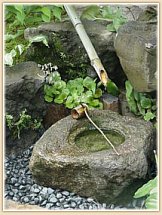  Purification Using Salt Purification Using Salt
Salt 塩 (Shio) is another major element of purification. In Shintō ceremonies, salt is often sprinkled to remove impurities -- this act is usually called Shubatsu 修祓. Salt is sometimes placed outside homes in little piles called Mori Shio 盛り塩 (piles of salt), usually near the entrance, so people who enter the home are purified. Mori-shio may also be put at the four corners of a plot to purify the area (especially before one moves in). Elsewhere, Japanese sprinkle salt over the shoulder after attending a funeral (although funerals are typically Buddhist affairs, a small package of salt is always given to mourners who attend the funeral ceremony). Restaurants may place small piles of salt at the entrance to their eateries. The origin of placing salt piles outside restaurants, some say, was to encourage wealthy clients to enter the establishment -- they rode horseback in the old days, and horses love salt. But this tradition may have originated elsewhere. According to one Chinese story, the Chinese emperor had many wives, who he would visit in turns. One of the wives, hoping to encourage the emperor to visit more often, spread salt outside her house, and the beasts pulling the emperor's carriage would stop in front of her home to lick up the salt. Maki Shio 撒き塩 (scattered salt) is throw around the boundaries of the house to stop impurities from entering the home area. Before buildings are erected, salt is scattered on the empty plot to pacify the earth kami. Salt is also offered to the spirits on the household altar (kamidana 神棚) and at shrines, and in both cases, it is usually gathered together into small or large conical piles. In the Kojiki 古事記 (712 AD), Japan’s oldest extant document, the first land mass (Onogoro Shima or Onokoro Shima 磤馭慮島, or “self-congealing island”) was formed when the creation gods stirred the primordial oceans, causing salt to separate from the brine. <Learn more about Shubatsu at Kokugakuin University’s Shintō site>
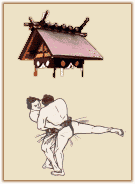 Salt and Sumo 相撲 Wrestling Salt and Sumo 相撲 Wrestling
Sumo wrestling began as a Shinto ritual to pray for a bountiful harvest. Introduced into ceremonies of the Imperial Court sometime in the Nara Era (8th century). Most modern-day Sumo traditions were developed under the patronage of the court. In the Edo Era, professional sumo groups were organized to entertain the rapidly expanding merchant class. Above the modern-day sumo ring is a canopy with Shinto attributes (looks like a mini-shrine). The tossing of salt before individual bouts (a purification rite), and the opening and closing Sumo ceremonies, all reflect Sumo’s Shinto origin.
Salt is scattered in quantity by sumo wrestlers before each bout to purify themselves and the sumo ring (dohyo). The dohyo is considered a sacred place, and regrettably women are not allowed to enter it because they are considered impure. Huh? Shinto revers the Sun Goddess Amaterasu, so I am not sure why this bias against women continues to exist. One young female wrestler who won a regional sumo competition for primary school children was not allowed to enter the professional ring to collect her prize from a famous pro wrestler. Approximately 45 kilos of salt are scattered every day at national sumo tournaments (must confirm this; need to find source).
Says Matsumura Masahiro, a professor of international politics at Momoyama Gakuin Daigaku (St. Andrew's University) in Osaka: "Perhaps no other sport is pursued as religiously as sumo wrestling. Before a match, referees — who double as Shinto priests — purify the seaweed, salt and sake. Wrestlers wash their faces, mouths and armpits before entering the dohyo (ring), on whose sacred sand neither shoes nor women may tread. Before a match starts, the two contestants raise their hands to show that they are not hiding weapons in the folds of their loincloth-like belt." <end quote, Japan Times article, July 27, 2010>

  Praying Etiquette, Ringing of Bell, Clapping of Hands Praying Etiquette, Ringing of Bell, Clapping of Hands
- Pass through the torii (entrance gate).
- Find the stone wash basin and proceed to wash your hands and rinse your mouth. Use the dipper to pour water over your hands, and then, using the dipper again, pour some water into your cupped hand. Put that water into your mouth and gargle. Do not bring the dipper into direct contact with your mouth. [Nowadays, most Japanese shrine visitors dispense with gargling, but most wash their hands.]
- Proceed to the main hall of worship. Ring the bell that hangs from a rope in front of the offering box (some shrines don’t have the bell/rope). Bow twice, clap your hands twice, bow once more, and then throw coins into the wooden offering box (100 yen is a typical offering). The prayer is made either before or after throwing money into the box. Another method is to throw a few coins into the offering box, then ring the bell, bow deeply twice with hands together, clap twice, and bow once again. When in doubt, watch how the Japanese people in front of you make their offering and prayer.
- Why the clapping of hands (拍手 = Kashiwade) and/or the bell ringing?
Here are some common explanations I have heard:
- To make sure the Shintō deity is listening. At Nishinomiya Jinja 西宮神社 (Hyogō Pref.), the head shrine of Ebisu worship in Japan, it is said that Ebisu (god of good fortune, the ocean, and fishing folk and one of Japan’s Seven Lucky Gods) is rather deaf. Thus arose, says the shrine, the widespread custom of clapping hands before one prays to shrine deities in order to gain the attention of the gods.
- Sound made by the closing of the cave door after the all-important sun goddess Amaterasu came out of the cave where she had been hiding.
- According to the Kojiki 古事記 (Japan's oldest surviving text complied around 712 AD) and Nihon Shoki 日本書紀 (Japan’s second oldest book, compiled around 720 AD), the sound made by clapping hands is the same sound that divided chaos into heaven and earth and gave birth to Japan. [Editor’s note: This appears to be incorrect. An alert site reader wrote me saying “I can’t find any references to this in the mentioned documents.” Nor could I after searching both documents at the online translations of the University of California, Berkeley. To search their online translations, see sunsite.berkeley.edu/jhti/cgi-bin/jhti/vocasel.cgi.

 Three Shintō Regalia 三種の神器 Three Shintō Regalia 三種の神器
Shintō sites associated with the imperial family typically enshrine three items (not typically displayed to the public) -- a sacred mirror, sword, and jewel. These three are known as the Imperial Regalia of Japan 三種の神器 (Sanshu no Jingi), also translated as the Three Sacred Treasures. The sacred or divine mirror, known as the Yata no Kagami 八咫鏡 or Shinkyō 神鏡, is a symbol of the sun goddess Amaterasu. Japan’s imperial family claims direct descent from her lineage. The sword (Kusanagi 草薙劍) was found in the tail of the dragon slain by her brother Susano-O-no-Mikoto, and the jewel (Yasakani no Magatama 八尺瓊曲玉) is an ancient and holy Shintō talisman. The mirror and jewel (or necklace) are said to belong to Amaterasu. The mirror by tradition is said to reflect her image. It is the mirror in which she sees her reflection after coming out from hiding in her cave. See Amaterasu for details. The sword was found by Susano, who tricks the eight-headed eight-tailed serpent of the Hino River in Izumo into drinking sake. Susano then kills it as it lies in a stupor, and finds the sword in one of the serpent's tails. The three regalia also represent three virtues, with the mirror representing wisdom, the sword representing valor, and the jewel representing benevolence. It is commonly believed that the original mirror is located at the Grand Shrine of Ise (Mie prefecture), the sword at Atsuta Jingū 熱田神宮 (in Nagoya), and the Jewel at the Imperial Palace (in Tokyo). The origin and authenticity of these items, however, is unknown. Ise and Atsuta are both dedicated to the Shintō sun goddess Amaterasu. Shintō’s divine spirits are said to reside within these objects. They are typically placed on the main Shintō altar, but they are not displayed for public viewing.
Other Key Terms
- Goshintai 御神体. Objects of Worship; also translated as True Body-Spirit of the Deity.
- Mitamashiro 御霊代. Objects worshipped as symbols.

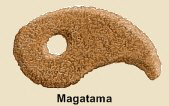  Magatama Magatama
The magatama (勾玉 or 曲玉) is a Shintō talisman of good fortune in Japan, a bead with religious significance in Japan’s Shintō traditions. Magatama literally means "curved ball." The magatama is an ancient Japanese Shinto ornament, which most believe was introduced to Japan from Korea around the 3rd-4th centuries AD. From early on, the magatama symbolized "avoidance of evil" or the "magic of good fortune." Its origins are clouded in uncertainty. Some say it represents the shape of an animal tusk, and hence came to represent good luck in agriculture and husbandry. Others say it came from an ancient Korean diagram representing the mother's womb, or embryo, and hence came to mean all good things, like the blessing of a new child, growth, longevity, and properity. For more details, please see the Magatama Page.

 Animal Guardians Animal Guardians
A pair of Shishi 獅子 (lion-dogs; also called Koma-inu) traditionally stand guard outside the gates of most Japanese Shintō shrines. In contrast, Buddhist temples are typically guarded by the Niō Protectors 仁王, although it is not uncommon to find Shishi guarding temples as well. Furthermore, on the eaves of both shrine and temple roofs, one can frequently find carvings of this mythical beast. As guardians outside the shrine gate, one Shishi is depicted with its mouth open (to scare off demons) and the other with its mouth closed (to shelter and keep in the good spirits). Another traditional explanation for the open/closed mouth relates to Ah and Un ("Ah" is the first letter in the Japanese alphabet and "Un" is the last). The combination is said to symbolically represent birth and death. This mythical and magical beast was probably introduced to Japan from China via Korea in the 6th or 7th century AD, during the same period as Buddhism’s transmission to Japan, for the Japanese Shishi combines elements of both the Korean "Koma-inu" (Korean dog) and Chinese "Kara-shishi" (Chinese lion).
At Inari Shrines, which are dedicated to Inari (the god/goddess of agriculture), the shrine is typically guarded by two Kitsune 狐 (fox), one at the left and one at the right. The fox are messengers of Inari 稲荷. At Hie Shrines 日吉, which are dedicated to the mountain kami Sannō 山王, the shrine is typically guarded by two monkeys. See Shintō Deities Page for more on animal guardians.
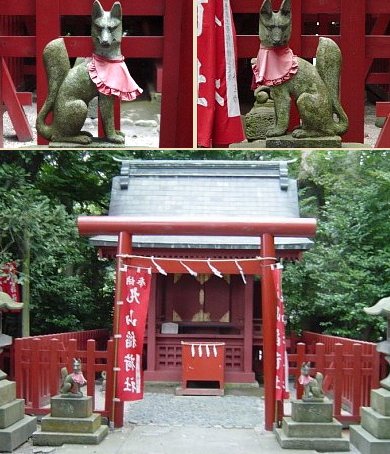
Fox guardians outside the gates to the Inari Shrine
(located inside Tsurugaoka Hachiman Shrine in Kamakura city)

 Torii (Gate) 鳥居 Torii (Gate) 鳥居
|
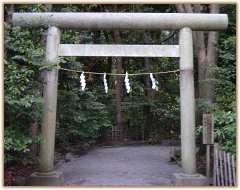
There are two kinds of Torii. If the gate is a plain one, without any decoration on it, you know that it is a ”pure” Shinto shrine. If the shrine has a plaque on it’s gate, it is Ryobu Shinto, which means Shinto that has been influenced by Buddhism. (Note: unconfirmed, must verify)
|
|
Torii literally means Bird Perch. Shrines always have gates called torii (often red if made of wood) to demarcate the sacred area inside the shrine. The sacredness of the torii has caused some difficulties in construction-happy Japan, says Kondo Takahiro (he maintains a wonderful site on Kamakura’s shrines and temples.)
Says Mr. Kondo:
At the Haneda Airport in Tokyo, a 7.2-meter-high torii gate stood in the way of a planned new runway. The gate itself was originally erected at the entrance of the Anamori Inari Shrine before World War II, but after the war, American Forces requisitioned the area and the shrine was moved. However, the torii was allowed to remain there, as local residents objected to the move, fearing punishment by the Shinto deities. Then came the problem of the new runway, which would require the dismantling of the gate. Again, locals protested in fear that it might incur divine wrath. Government authorities compromised, and decided, instead of dismantling it, to relocate it to a bank of the Tama River, about 800 meters away from the former site. But it is unconstitutional for the government to cover the “total cost” for removing or relocating any religious structure. After long discussion, it was agreed that part of the cost would be paid by the private sector, and the torii was finally relocated in February 1999.

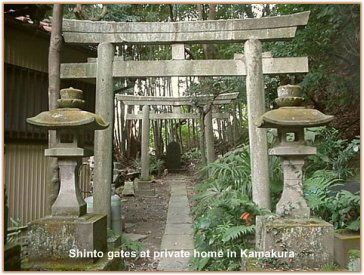 MORE ON TORII MORE ON TORII
Below text courtesy JAANUS.
Although there are an infinite variety of torii named for unique characteristic, or for the name of the shrine itself, basically all torii can be classified under two major categories: those with straight members, shinmei torii 神明鳥居, and those with curved members, myoujin torii 明神鳥居. In both cases the terms are loosely applied to torii which fit these simple descriptions. However, shinmei and myoujin also refer to specific styles of torii.
1) Torii with Straight Beams (shinmei torii 神明鳥居)
- ise torii 伊勢鳥居
- kasuga torii 春日鳥居
- hachiman torii 八幡鳥居
- kashima torii 鹿島鳥居
- kuroki torii 黒木鳥居
2) Torii with Curved Beams (myoujin torii 明神鳥居)
- inari torii 稲荷鳥居
- sannou torii 山王鳥居
- miwa torii 三輪鳥居
- ryoubu torii 両部鳥居
- mihashira torii, mitsuhashira torii 三柱鳥居
- Three famous myoujin type torii with some noticeably unique characteristics are referred to by the name of their shrines:
- shitennouji ishi torii 四天王寺石鳥居
- usa torii 宇佐鳥居
- hakozaki torii 筥崎鳥居
Before the Premodern Period (1568-1868), the proportion of parts of torii varied greatly. From the end of the 16th century, the general dimensions were prescribed, with the diameter of pillars to be about equal to 1/10 the distance from pillar center to pillar center. According to the SHOUMEI 匠明, Five Secret Books for Master Carpenters (1608, Edo period), the height of the pillar from the ground to the underside of the tie beam must be determined by a square constructed from the edges of the pillars. A circle is then inscribed. The underside of the tie beam coincides with the upper most perimeter of the circle. The projection of the tie beam is calculated by dividing its length into 3rds from pillar center to pillar center. The ends of the tie beams should project 1/3 of that length. The slanted cuts (tasukizumi 襷墨) on the ends of the lintels are determined by a line projected (nagarezumi 投墨) from the bottom center of the pillar to the upper or lower corners (uwakado 上角, or shitakado 下門) of the tie beam.
- LINKS to Japanese Torii and Shinto Architecture
Below links provided courtesy of GABI
See her site at: darumamuseumgallery.blogspot.com/2009/10/torii-gate.html
- www.japan-photo.de/e-torii.htm (Torii Styles Photo Tour)
- www.marimari.com/content/japan/best_of/architecture/main.html
- www.asianinfo.org/asianinfo/japan/architecture.htm
- www.lib.ohio-state.edu/rarweb/japan/2_6_photos.html
- www.sg.emb-japan.go.jp/JapanAccess/kenchiku.htm
- www.fact-index.com/a/ar/art_and_architecture_of_japan.html
- www.genbu.net/tisiki/toriisinmei.htm (J)
- http://baum3.hp.infoseek.co.jp/newpage119.htm (Terms, E)
- http://www.genbu.net/tisiki/ (Terms, J)
- http://home.uchicago.edu/~krgorden/archpaper.html
- www.town.shikishima.yamanashi.jp/date/bunkazai.html
- www.jmam.net/b/kindai/touroku12.htm
- www.greatbuildings.com/buildings/Torii_of_Itsukushima.html (J)

 Shimenawa 注連縄 Shimenawa 注連縄
Sacred places are typically marked with a shimenawa (special plaited rope) and shime (strips of white paper). Placed at the entrances of holy places to ward off evil spirits, or placed around trees/objects to indicate presence of kami. Made of rice straw or hemp, the rope is called nawa 縄. The pieces of white paper that are cut into strips and hung from these ropes (often hung from ropes on Torii gates as well) are called shime 注連 or gohei; they symbolize purity in the Shintō faith.
Merchants and businesses, as well as private individuals, often hang the shimenawa on their front doors at special times of the year. One also often sees the Tamagushi 玉ぐし, a sprig of Cleyera orchnacca with attached white-paper-strips (called ”shide”) used by Shintō priests at ceremonies.
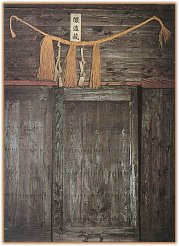 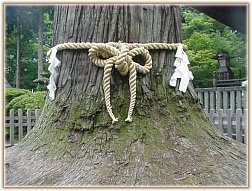
Left: Shimenawa hanging from door of sake brewery Imada Shuzo.
Right: Shimenawa at Tsurugaoka Hachimangū Shrine in Kamakura

 Shrine Buildings: Haiden and Honden and Heiden Shrine Buildings: Haiden and Honden and Heiden
Haiden 拝殿 or Worship Hall
Honden 本殿 or Inner Shrine
Heiden 弊殿 or Hall of Offerings
A full-fledged Shintō shrine is typically a two-part structure: (1) the Haiden, or oratory, before which worshipers say prayers and (2) the Honden, or inner sanctum, the main dwelling of the deity. The Honden is built behind the Haiden. One also often finds a third structure between the Honden and Haiden called the Heiden (Hall of Offerings), open only to the priests when they are making offerings on behalf of evotees.
In contrast to the wonderful sculptures found at Buddhist temples, the ShintōHonden contains no statues of the Shintō deities, but it does house the sacred mirror, sword, and jewel -- the main regalia of Shintō shrines, symbolic objects of worship in which the spirit of the deity is believed to reside. Since the Honden is considered a sacred sanctuary, laity are not allowed to enter. Thus, Shintō ceremonies for the common folk are held in the Haiden.

 Shinto Architecture Shinto Architecture
If you see a work of sacred architecture from before the Meiji Era (1868-1912) that rises on a monumental scale, it is apt to be Buddhist. Shintō architecture is usually “down to earth,” blending rather than conflicting with the natural setting. Shrines are typically stand-alone complexes, but shrines can often be found within Buddhist temples as well. Shintō roofs are usually peaked, and most everything is painted red (but not always). The presence of a torii (gate), two shishi (lion-dog) guardians, shimenawa (ropes with white paper), and the absence of a cemetery, are all telltale signs of Shintō shrines. Buddhist temples, however, are generally more ornate, showing strong influences from China. Temples typically contain a cemetery.
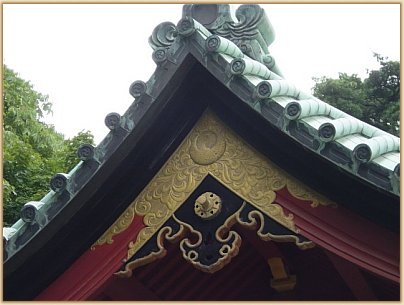
The roof above the purification font at
Tsurugaoka Hachimangū Shrine in Kamakura
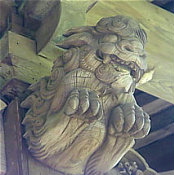 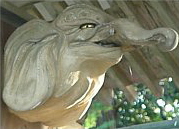
Wooden shishi (lions) lend beauty to both Shintō and Buddhist structures.
Shishi are commonly placed under the eaves of religious structures
to ward off evil spirits. Sometimes the shishi are accompanied by
other protective deities, such as the above elephant-like creature
(baku 獏, known as eaters of nightmares in Japanese mythology).
Images of the dragon are also found frequently as architectural elements
(kibana 木鼻 - decorated beam-ends) at temples, less so at shrines.
BAKU 獏, a mythological Chinese creature thought to devour
(i.e. prevent) nightmares, is sometimes written on the sail of the
Treasure Boat of Japan’s Seven Lucky Gods.
Says reader Ken Prescott: “The elephant-like animal often associated with shishi, and used like the shishi as architectural decorations (kibana - decorated beam-ends), are probably the baku, known as eaters of nightmares in Japanese mythology. They are a composite animal, I think unique to Japan, and are very often depicted in netsuke. In fact, probably the best English-language references and examples are to be found in books on netsuke. I have also seen drawings from the Kano school (or influenced by same) with both baku and shishi, and know of one ukiyoe (woodblock) print showing a baku on a bed cover (appropriately). The Tokugawa shrine at Nikko is loaded with dragons, baku, and shishi.” <end quote>

BAKU 獏 - The Eater of Nightmares
Edo Period. Photo courtesy www.buddhastatuesnow.com

 Shrine Architecture Shrine Architecture
Below text courtesy Ed Jacobs.”You can tell whether the deity housed at the shrine is male or female by looking at the roof of the shrine. On some shrines (not all though) you may find horn-like cross boards on the roof. If the ends of the boards are cut so the flat edges face up, then the deity is usually female. However, if the boards are cut so the flat edges face sideways, the deity is usually male.” (NOTE: unconfirmed, must verify)
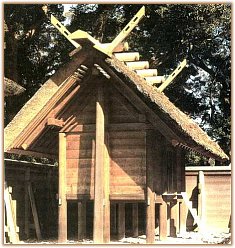
Flat edges face sideways, indicating male deity
Photo courtesy www.ias.berkeley.ed
Chigi 千木 or Cross Beams
Katsuogi 堅魚木 or Short log-shaped sections
Below text courtesy Basic Terms of Shintō (Kokugakuin University)
The crossed beams extending upwards from both ends of the roof gables in Shintō architecture are called Chigi 千木. The short log-shaped sections set horizontally on the roof at right angles to the ridge are called Katsuogi 堅魚木. Both date to ancient times. Chigi are normally found on all Honden, except in the Gongen style (a noteworthy exception being Nikko Toshogū). At Ise Jingū they are found on all structures.

 Lucky Charms, Votive Plaques, and Fortune Telling Lucky Charms, Votive Plaques, and Fortune Telling
- O-mamori お守り or Protective Amulets
- O-inori お祈り or Paper prayers
- Hamaya 破魔矢 or Evil-Destorying Arrow
- Ema 絵馬 or Votive Plauque
- Omikuji おみくじ or Lucky or Unlucky Oracle
- Magatama 勾玉 or 曲玉, and ancient Shintō talisman of good fortune
Shrines offer many diversions to visitors -- and if most cases, these diversions involve superstition and magic. Nearly all shrines sell talismans to bring good luck or keep evil away (so do most Buddhist temples for that matter). Lucky charms and protective amulets are called o-mamori お守り. Shrines also sell o-inori お祈り(prayers to the kami written on pieces of paper) that magically help students pass examinations or sick people recover from an illness. Some shrines sell hamaya 破魔矢 (evil-destroying arrows).
|
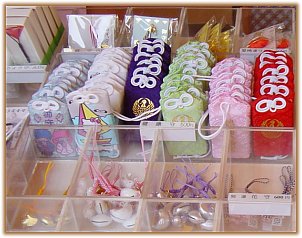
お守り Omamori
Various luck charms sold at the shrine. Some uses might
be to hang inside the car for safety while driving, or
to hang in the study to pass school entrance exams.
|
|

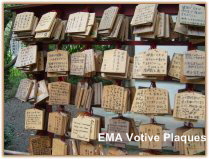  EMA 絵馬 EMA 絵馬
Ema are votive plaques. At most shrines, one finds a stand with hundreds of small wooden plaques attached to it. These votive plaques, sold at the Shrine, are called ema. Worshippers buy the plaque, write their wish on it, then hang it on the ema stand, in hopes the shrine deity will grant their wish. All types of wishes are made -- couples hoping to have children, students hoping to pass school exams, people looking for true love, etc.
 OMIKUJI - GOOD LUCK, BAD LUCK OMIKUJI - GOOD LUCK, BAD LUCK
THE “OMIKUJI” FORTUNE. Most shrines sell fortunes called Omikuji おみくじ. Just look for a small rounded container filled with bamboo sticks at the shrine kiosk. Pay the attendant (typically 100 yen), pick up the container, give it a shake, and a long stick will pop out of a small hole at the top. The stick will have a number, which corresponds to a fortune. Based on your number, the attendant gives you a tiny slip/roll of paper on which is written your fortune. If you draw a good fortune, keep it, take it home with you. But if it’s bad, leave it at the shrine, don’t take it home. Just look around, and you’ll find a small stand with many strips of white paper tied on. These are bad fortunes and you should tie yours here too. The concept is “leave the bad luck at the shrine, were the divine spirit can exorcise it.
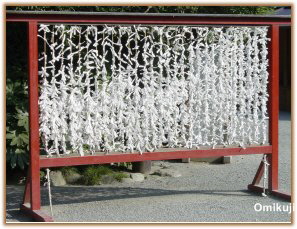
Bad-luck fortunes are tied to this rack and left at the shrine
Some shrines have done away with the “stick-with-number” tradition, replacing the entire process with automated vending machines. Just pop in 100 yen, and out comes your fortune.
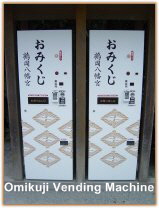

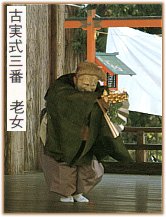  Kagura & Gagaku = Ritual Dancing & Music Kagura & Gagaku = Ritual Dancing & Music
Kagura 神楽 are ritual dances accompanied by music called Gagaku 雅楽. Gagaku is the traditional music of the Japanese Imperial Court. Even today, the Imperial Household Agency maintains the Imperial Ensemble. Its musicians are hereditary, dating from the ninth century. Among them is the Togi family, who are now employees of the Imperial Household Agency. Kagura and Gagaku are considered vehicles of communication between the Shintō deities and worshipers. Standard instruments include:
- sho (a reed-free mouth organ made of 17 bamboo)
- biwa (a short-necked lute); the goddess Benzaiten is often shown carrying a biwa
- hichiriki (a double-reed pipe like a small oboe)
- taiko (drums)

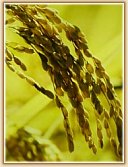  RICE, MOCHI, & SAKE RICE, MOCHI, & SAKE
Rice is a long-standing staple of the Japanese diet, and it is not surprising that rice is offered in prayer and praise to Shintō deities throughout Japan. In many Shintō ceremonies, pounded rice cakes (Mochi 餅) are offered to the deities by Shintō priests on behalf of the local community. According to some, each grain of rice symbolizes a Tamashii 魂 (human soul), and thus a rice cake is said to symbolize millions of souls.
In olden times, the rice was hand-pounded by the community in an event known as Mochitsuki 餅つき (lit. “making rice cakes”). Even today, Shintō and secular groups in Japan typically gather to make mochi on the third day before the New Year. This is mostly a community event, but to some, it is also a rite of self purification. Sake, which is made from rice, is one of the five Shintō elements of purification (water, salt, fire, sand, and sake) and is offered to the deities and worshippers at Shintō ceremonies and used symbolically in weddings (see Sansankudo 三々九度).
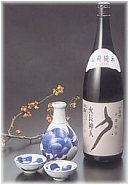 Sake 酒 -- known as Nihonshu 日本酒 or rice wine. In olden days, sake was produced in the shrine’s Sakadono 酒殿 (wine hall). At religious ceremonies, the communal partaking of Miki 神酒 (another name for sake) is called Naorai 直会. The Naoraiden 直会殿 (or Noraidono 直会殿 or Gesaiden 解斎殿) is the name of the shrine building where priests retire after offering food and drink to the gods. For a few more details, see JAANUS. Various types of ritual sake -- e.g., Shiroki 白酒 (light) and Kuroki 黒酒 (dark) -- are typically presented as offerings at important festivals (such as the Niinamesai and Daijosai festivals). According to the Engi Shiki 延喜式 (Procedures of the Engi Era, 901 - 923 AD), divination was performed prior to production to determine what rice to use, and from what region to harvest. Dark sake was often made by mixing in the ashes of the Kusaki 草木 (type of arrowroot) or Utsugi 空木 (Deutzia scabra). Sake 酒 -- known as Nihonshu 日本酒 or rice wine. In olden days, sake was produced in the shrine’s Sakadono 酒殿 (wine hall). At religious ceremonies, the communal partaking of Miki 神酒 (another name for sake) is called Naorai 直会. The Naoraiden 直会殿 (or Noraidono 直会殿 or Gesaiden 解斎殿) is the name of the shrine building where priests retire after offering food and drink to the gods. For a few more details, see JAANUS. Various types of ritual sake -- e.g., Shiroki 白酒 (light) and Kuroki 黒酒 (dark) -- are typically presented as offerings at important festivals (such as the Niinamesai and Daijosai festivals). According to the Engi Shiki 延喜式 (Procedures of the Engi Era, 901 - 923 AD), divination was performed prior to production to determine what rice to use, and from what region to harvest. Dark sake was often made by mixing in the ashes of the Kusaki 草木 (type of arrowroot) or Utsugi 空木 (Deutzia scabra).
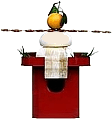 Sanku and Shinsen. Offerings to the deities. Sanku 散供 is the practice of scattering offerings of rice, sake, or money to the local deity or household deity. At the offering site, the offerings are typically scattered around the four corners and into the center. Shinsen 神饌 refers to offering food to the deities and includes Shintō staples like rice or rice cakes, sake, salt, and water. But just about anything will do, including fish, fowl, meat, seaweed, vegetables, fruits, or sweets. Some shrines still make rice in consecrated fields called Shinsenden 神饌田. The rice is then used in shrine ceremonies. The supervisor of the Shinsenden is called the Kamiyaku 神役. These sacred rice paddies are worked entirely by hand (no animals are used). Jukusen 辭滄 refers to cooked food, Seisen 生饌 means raw food, and Sosen 素饌 means vegetarian food. Sanku and Shinsen. Offerings to the deities. Sanku 散供 is the practice of scattering offerings of rice, sake, or money to the local deity or household deity. At the offering site, the offerings are typically scattered around the four corners and into the center. Shinsen 神饌 refers to offering food to the deities and includes Shintō staples like rice or rice cakes, sake, salt, and water. But just about anything will do, including fish, fowl, meat, seaweed, vegetables, fruits, or sweets. Some shrines still make rice in consecrated fields called Shinsenden 神饌田. The rice is then used in shrine ceremonies. The supervisor of the Shinsenden is called the Kamiyaku 神役. These sacred rice paddies are worked entirely by hand (no animals are used). Jukusen 辭滄 refers to cooked food, Seisen 生饌 means raw food, and Sosen 素饌 means vegetarian food.

 Scriptures, Sacred Texts, Shinten 神典 Scriptures, Sacred Texts, Shinten 神典
Shinten 神典 refers to the main texts of Shintō, even though Shintō has no systematized canon. That is, Shintō is not defined by any specific set of scriptures such as the sutras of Buddhism or the Bible of the Christians. Yet, a few classic sources of Shintō thought are considered the wellspring of Shintō myths and legends. They are:
- Kojiki 古事記 (712 AD, Record of Ancient Matters)
- Nihon Shoki or Nihongi 日本書紀 (compiled around 720 AD, The Chronicles of Japan)
- Kogo Shūi 古語拾遺 (807 AD)
- Manyōshū 万葉集 (8th century, Japan’s oldest volume of verse)
- Fudoki 風土記 (Circa 713; other works with same name appeared in Tokugawa era)
Says the Kokugakuin University: “These works contain mythological accounts and historical records concerning matters such as the origin of the world, the birth of the land, the appearance of the gods and goddesses and of all things in the universe, the establishment of the nation, and the relation of the gods to government, ceremonies of worship, manners and customs, and Shinto attitudes and norms. Most of Japan’s surviving mythology comes from the Kojiki and Nihon Shoki. They tell of the origin of the ruling class, and were apparently aimed at strengthening its authority. Therefore, these two works have much political coloring. They are based on two main traditions: the Yamato Cycle, centered around the sun goddess Amaterasu Omikami, and the Izumo Cycle, in which the principal character is Susanoo no Mikoto, the brother of Amaterasu.
Shintō’s sacred scriptures do not equate to the systematized canon or written scriptures of the Bible or the Koran, although ceremonial prayers to the Shintō deities -- called Norito 祝詞 -- are traditionally chanted even today by shrine priests. The scholar Motoori Norinaga 本居宣長 (1730 – 1801 AD) says that norito are sacred incantations used by humans to address the gods, while others say norito are commands issued by the gods to humans. The norito are typically chanted in an archaic form of Japanese or Chinese, and not many shrine visitors have a clue to the meaning -- i.e., the laity don’t understand the incantations. Since Shintō beliefs are based around the concept of purification, it is also not surprising that Shintō practitioners believe good words produce good effects, while bad words produce evil. Norito are good words. Another important Japanese term is thus Kotodama 言霊, meaning the “spiritual power residing in words."
Below text courtesy Encyclopedia Britannica: “Genealogies and mythological records were kept in Japan, at least from the 6th century AD. By the time of Emperor Temmu 天武 (7th century), it became necessary to know the genealogy of all important families in order to establish the position of each in the eight levels of rank and title modeled after the Chinese court system. For this reason, Emperor Temmu ordered the compilation of myths and genealogies that finally resulted in the Kojiki and Nihon Shoki. The compilers of these and other early documents had at their disposal not only oral tradition but also documentary sources. While the Kojiki is richer in genealogy and myth, the Nihon Shoki adds a great deal to scholarly understanding of both the history and the myth of early Japan. Its purpose was to give the newly Sinicized court a history that could be compared with the annals of the Chinese.

LEARN MORE

|
|